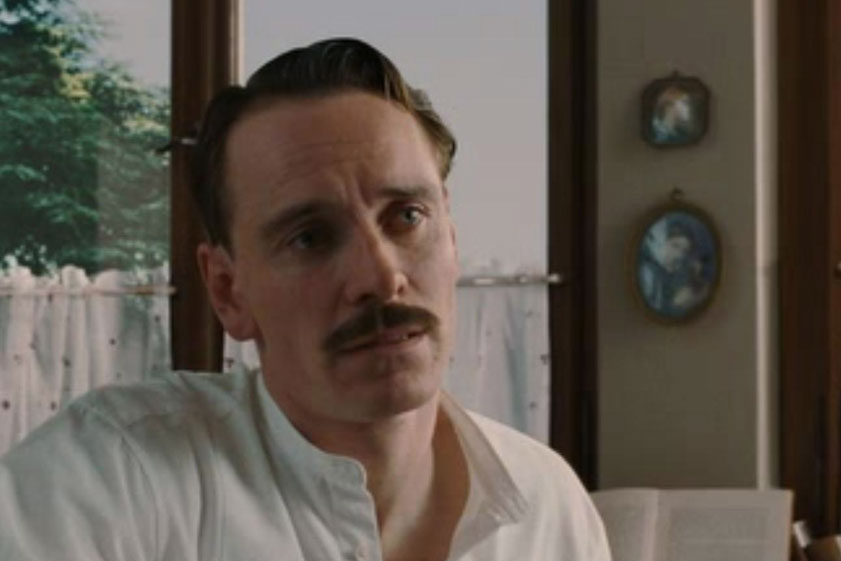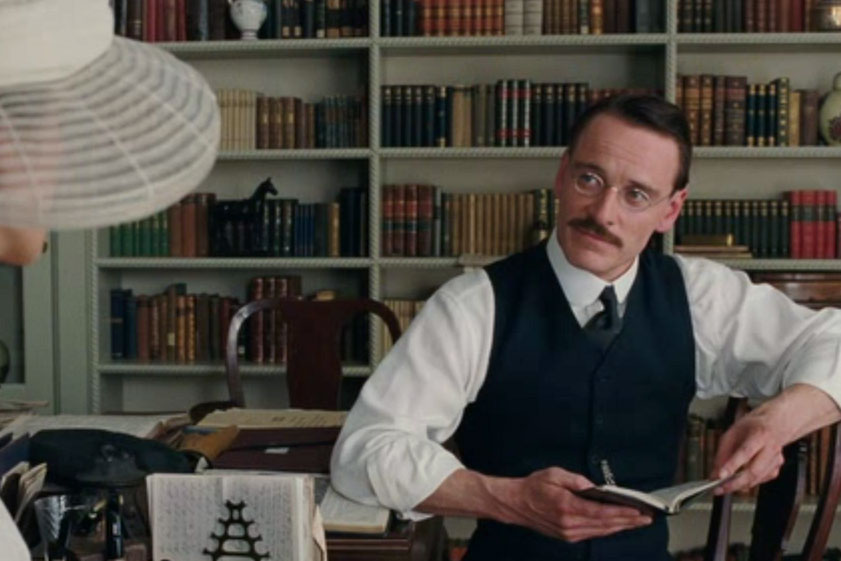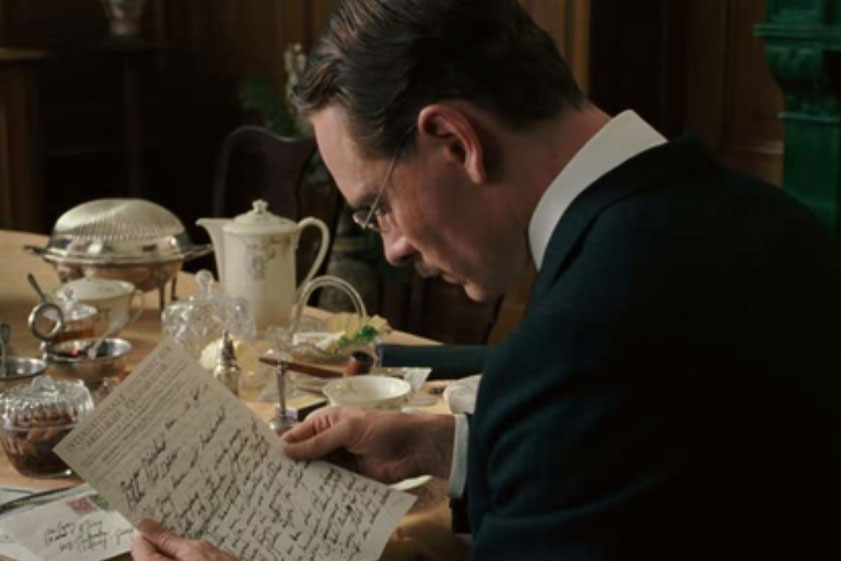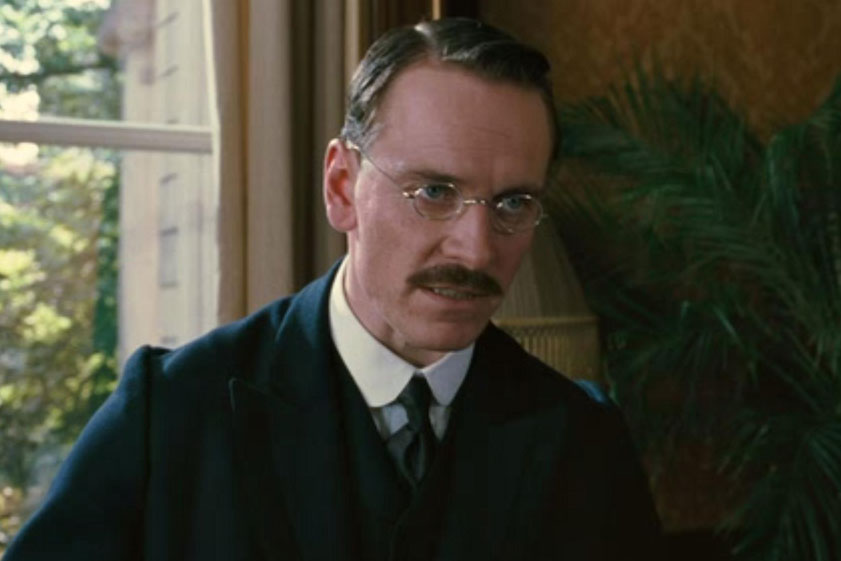
|

|

|

|

|

|

|

|

|

|

|


On Jung's ideas and how do they woven into our everyday life:
When I started looking into it and researching it, I realized just how much of his teachings, philosophies, ideas are intrinsic in our vocabulary. How it's in our everyday use now - the idea of extrovert, introvert, personality type. That was quite cool to find that out. Other than that it was pretty basic. So I had some work to do there. And it's a matter of digesting all the information and kind of throwing it away and going back to the script. I realized there was various stages to his life. Different Jungs in different times of his life. So the guy I was trying to portray was young, still had a lot to prove in his profession. So I wanted to have an element of unsurity there and insecurity, if you like. He's very much representing the time that he lives in the stiff collars. He's conforming to the social etiquette at play for the time. Your dealing with Europe in the early 1900's and the belief that they were this hyper-socialization. Of course World War I was right around the corner and proved that theory totally wrong. So I looked at various stages in his life. The Red Book was interesting for me to take a look at because that was the Jung that comes right after the movie. He has his breakdown, comes through that and then comes up with The Red Book. There's also footage of him on YouTube. I could watch some interviews, when he was in his 60's or 70's, there was an old man that seemed very self-assured and seemed very confident in his life's work. And he was very charming. I got a feeling of sensuality in him, through his physicality. Gathering all that information and trying to find where that applies best in that story.
On Hysteria, which presently is a very popular topic:
I know its to do with the womb isn't it. Hysteria it comes from the Latin they used to take women's wombs out because they believed it was linked to this madness. What I think was pretty amazing with the Burgholzi, this was a forward way of thinking. It was actually a good place to go to if that point in history you were deemed to be insane or cuckoo. As we see with Sabina, she goes into the Burgholzli as a patient and she comes out as a doctor. These were very forward thinking people for the times especially to have the patience and interest in these cases. And also different approaches to allow this talking cure. That's what really binds Jung and Sabina together because he's trying out this method in dealing with hysteria through the talking cure this new method that she's suffering in it. And she gets cured by it and he also gets this sort of validation with his beliefs so that forms a really strong relationship between them.

On Jung's theory:
I'm not sure. I don't know I have any real set beliefs in anything. I'm kind of open to anything. It's funny sometimes you think something greater is at play and you look at the series of events that lead you to here from here.
On threadline of "A Dangerous Method" and "Shame":
I didn't really relate the two together at all. Its only in hindsight that you see that. I did DANGEROUS METHOD, X-MEN [FIRST CLASS], and then SHAME. I kind of work very intensely on the project running up to it and during it and then I flush it pretty quickly too. I was jumping from one project to the next so I had to get rid of them pretty quickly. And how was it playing either of them? You have the information there, that's your biography that's taken care of so in a lot of respects that can be easier. You have the information there, available, where as if you are doing a fictional character, I go and write that book/ biography that's given to me in the script. Logically what would a child go through... to sort of create this motivation. Were they popular in school? Were they a loner? Were they sporty? Academic? Then I spend a lot of time with the script. That's the process I take on with the script for all of the work, regardless of what it is. Through re-reading, I'm spending a lot of time with the character and in their world. It's like slipping into a new set of skin. With SHAME as well I got the opportunity to meet people suffering from the condition and that was a huge insight. I'm very grateful for that for the honesty and bravery of these people to come forward like that. Especially for this one guy in particular, with the idea of the intimacy problems that Brandon has that's really the crux of his problems. This guy that I met, that was exactly his problem as well. It helped me understand the condition.
If Dr. Jung were ever treat Brandon:
He'd probably tell him it's alright. You know? The first stage. Let's just talk about it. I think what's so interesting about these guys is they were really truly fascinated by human behavior why we behave in certain ways. Again there's a certain social sort of form that we're expected to live under and behave a certain way with one another. But in actual reality and practice, what way do we really behave. He'd say everything was going to be ok and go see my friend Siggy Freud.
I suppose that doctor-patient transference, it is that thing. We all find doctors sexy. That's why there's so many TV shows about doctors because they have the power to save lives and there's something very attractive about that. It's a very intimate place. You have the patient and the doctor and they go to intimate places together. That can bleed over for sure.

Actor-psycho-analyst
I think the similarities are that interest in human behavior and trying to understand certain personalities. Where moral compass lies. For sure, for me, my best reference for that is myself. I try to be really honest and truthful in answering those questions. Finding those elements in myself because essentially were all pretty much the same. Try to identify and understand as opposed to judge is very important in approaching characters.
On working with David Cronenberg:
I was a fan of his for sure. I was very jealous when they were filming EASTERN PROMISES, I live around Hackney where they were filming. I was like, "Oh God. Wouldn't it be great to be on a David Cronenberg set?" So it was very exciting at the prospect of working with him. And yes it was different than I expected because you see his films and they can be quite violent and dark. He's the opposite. He's sweet, loving energy, generous and very humorous. We would joke around on set which can always lend to the piece especially when your dealing with something set during a particular time. You don't want to get bogged down in the social etiquette of that day. You want to keep it accessible and fresh. Having that humor is a nice device for that as it keeps you relaxed and nice and light going into scenes that can be heavy and dialogue heavy. He's a joy. He's collaborative. Most of the great directors I've had the pleasure working with have to be great manipulators. They do their manipulation in the weeks leading up. So it's like a dinner here. Or your trying on your costumes or picking the props. The nudges they give you. Once we get on set, there's very little dialogue as all of that has been discussed previous.
Main Theme
I think it's conflict first and foremost. I think what we do is heightened reality. People go, "Well, it's not real." Well real can be really boring. We are asking questions and seek out drama. The best way is to seek out conflict- conflict between characters and conflict within the characters itself. I think it makes for more interesting viewing. Makes it more provocative. Like something like FISH TANK, you think, "I kind of like that guy. Oh shit! He did that? I don't know how I feel about him now." You take a look and he's the one person in the film that gives her the encouragement. Tells her she's special and should have her dreams. Not to think she's a piece of shit and she's never gonna get out of this world. Then he oversteps the line and abuses his authority and position. That's life. I'm not like, "Here's the villain. Here's the good guy." That's kind of boring for me. What happens if you blur the two together?

On "A dangerous Method's" Screenplay:
No. I tried to treat it as a piece of music. It's very eloquent and elegant. It was getting a handle on the richer vocabulary that I had to really get on top of the rhythm of that piece like a piece of music.
On Jung, Freud and Sabina:
If the character comes into the room, I ask, "Who's in the room? How do that person make me feel? How do I make them feel? Do they make me feel inadequate? Do they make me feel powerful?" Whatever, you know? There's various stages of that with both the characters with the positions of power. Who's in control changes all the time. When she[Sabina] comes into the hospital at the beginning, I'm definitely the guy in control. By the time the end of the film she comes to visit me she's sort of a ease with herself and Jungs about to go into this breakdown. It's this thing with Freud. At the beginning Jung is all, "this is my hero and I get to meet him. This is the most amazing thing." And of course, the master-pupil relationship turns. In order for me to really grow and explore my theory of the psycho-analysis, I have to break away from the master and grow as an individual. What I think is so interesting with this, what Christopher has done, is you've got these heavyweights Jung and Freud but he shows them as very human, very flawed. These two guys had massive egos. I always found the script really funny. Viggo and I tried to find the comedy in it as much as possible. That was great as I've always been a massive fan and he's a wonderful human being as well.
